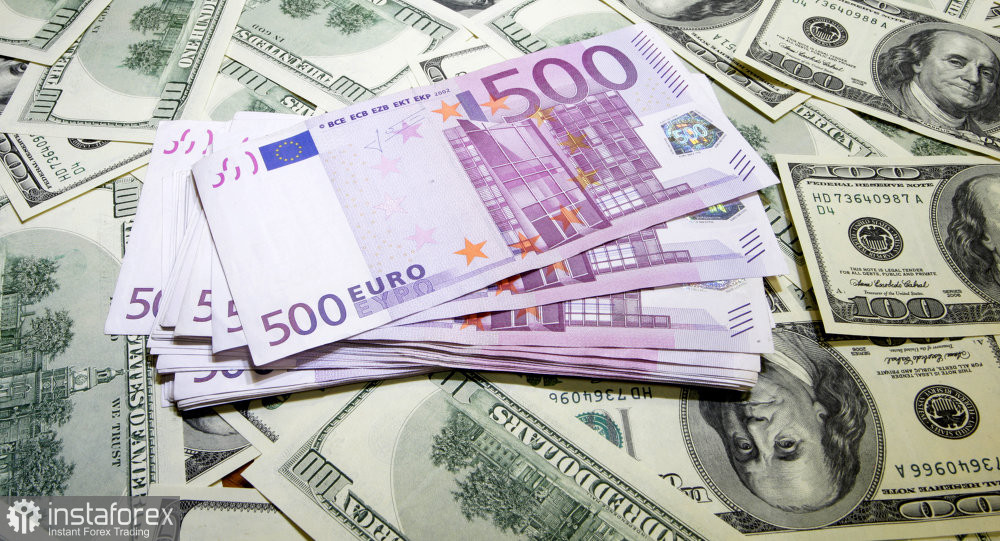The euro-dollar pair was unable to maintain its high: as soon as the EUR/USD bulls crossed the 1.0700 mark, the upward momentum began to fade, and then completely disappeared. The bears seized the initiative, after which the price rolled down to the area of the 6th figure. By and large, nothing extraordinary happened. The rise in prices is a priori corrective in nature - the only question is how large-scale this upward pullback will be. The upward momentum could well fade away in the area of 1.0650-1.0690, but the information flow of the last few days contributed to the price's further growth. First, the European Central Bank changed its rhetoric, outlining concrete prospects for tightening monetary policy in the foreseeable future (until September). Secondly, the markets reacted to US President Joe Biden's statement, who announced that the US could lift some of the trade restrictions on China imposed by the Trump administration. Amid a general increase in risk appetite, as well as thanks to European Central Bank President Christine Lagarde's hawkish signals, the EUR/USD pair confidently entered the 7th figure area on Tuesday, updating the monthly high at 1.0749.

But it is one thing to take the height, and quite another thing to keep it. Apparently, many traders took the rise in price as a good opportunity to enter short positions at a better price. Therefore, the pair began to gradually roll back during the US session on Tuesday. Market participants took profits and opened short positions, thereby putting pressure on the pair. This pressure intensified on Wednesday, and contrary to the opposite signals of a fundamental nature: rather weak macroeconomic statistics (orders for durable goods) were published in the United States, and ECB representatives again started talking about the likelihood of a 50-point increase in rates at the July meeting. But despite such a news background, the pair fell to the Kijun-sen line on D1, which corresponds to 1.0640. In this price area, the downward dynamics has slowed down.
All this indicates the indecisiveness - both bulls and bears of EUR/USD. Market participants doubt that the euro will be able to reverse the downward trend, due to the existing geopolitical risks, the impending energy crisis and possible stagflation, against the background of the sanctions confrontation with Russia. The dollar, in turn, is in demand as a protective tool. The optimism associated with the possible abolition of some US tariffs on Chinese products was quickly offset. Traders cannot ignore signs of economic slowdown in China, the US and Europe, amid rising inflation.
Let me remind you that at the beginning of last week a pack of macroeconomic statistics was published in China. The latest figures came out in the red zone, reflecting alarming trends. For example, the volume of industrial production decreased by almost 3%: for the first time in two years, the indicator fell into the negative area. The retail sales indicator disappointed. It collapsed to -11%. The last time sales showed such a sad result was in April 2020, when the coronavirus was raging in the country. It is also worth noting that sales sank amid rising unemployment. China's unemployment rate has risen for the fifth consecutive month, hitting 6.1% in April.
The PRC still adheres to the principle of "zero tolerance" for COVID-19, so the country's authorities have introduced strict quarantine restrictions in Shanghai and some other major cities of 25 million people. Such strict and, most importantly, large-scale measures destroy supply chains, which can lead to another jump in inflation, raising the threat of a global recession. By the way, the Shanghai authorities announced yesterday that they plan to consider lifting the lockdown no earlier than June. At the same time, in Beijing, the increase in infected people the day before yesterday amounted to 99 cases - this is the strongest rate of spread of the disease during the last outbreak. That is, the problem is far from being resolved.
If we talk about the growth prospects for EUR/USD, we should also not forget that the Federal Reserve is showing a more resolute and aggressive position compared to the ECB. For example, the chairman of the central bank of the Netherlands, Klaas Knot, again did not rule out raising rates by 50 basis points at once, but this time the market ignored this message. The fact is that a few days ago, Lagarde actually rejected this idea, saying that such a decision "has a price." At the same time, she agreed that the deposit rate would be gradually increased, bringing it to zero by September. She also did not rule out (but did not announce) "further increases."
The Fed will raise rates in 50-point increments in June, July, and most likely in September. This is a widely announced, and one might say, "baseline scenario", which can only change in the direction of tightening (a 75-point rate increase). Therefore, the ECB will in any case be among the "falling behind", even despite the tightening of the rhetoric of the ECB representatives.
It is likely that EUR/USD bulls will make another attempt to storm the 7th figure. At the moment, there are no powerful news reasons for the pair to go down to 1.0600 or below. Therefore, in the next few days, the pair may fluctuate in a 100-point range of 1.0650-1.0750. As soon as the upward or downward momentum fizzles out, bears or bulls will seize the initiative. In the current conditions, it is advisable to take a wait-and-see position, or open long or short positions from the boundaries of the above price range.
 English
English 
 Русский
Русский Bahasa Indonesia
Bahasa Indonesia Bahasa Malay
Bahasa Malay ไทย
ไทย Español
Español Deutsch
Deutsch Български
Български Français
Français Tiếng Việt
Tiếng Việt 中文
中文 বাংলা
বাংলা हिन्दी
हिन्दी Čeština
Čeština Українська
Українська Română
Română

